A silver shekel minted in the immediate wake of the Jewish revolt against Rome in the summer of 66 A.D. sold at auction Thursday, March 8th, for a record-breaking $1,105,375, including buyer’s premium. As far as we know, it’s the most expensive ancient Judean coin ever sold.
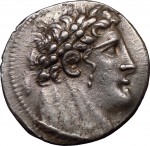 The reason it’s so valuable is that it’s a prototype. It was minted just a few weeks after the revolt broke out. In Jerusalem, the rebels defeated the Roman garrison and expelled their pro-Roman king Agrippa II (son of that Herod Agrippa who was raised at Tiberius’ imperial court along with the emperor’s son Drusus and the future emperor Claudius), claiming the Temple and its rich stores of Tyre silver shekels.
The reason it’s so valuable is that it’s a prototype. It was minted just a few weeks after the revolt broke out. In Jerusalem, the rebels defeated the Roman garrison and expelled their pro-Roman king Agrippa II (son of that Herod Agrippa who was raised at Tiberius’ imperial court along with the emperor’s son Drusus and the future emperor Claudius), claiming the Temple and its rich stores of Tyre silver shekels.
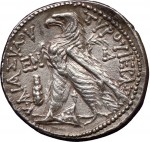 When Rome conquered Judea in the first century B.C., they disallowed the minting of local currency. By Talmudic law the Temple tax had to be paid in coins of high purity silver, and the shekels of Tyre were the only ones that qualified. They left a lot to be desired in other religious respects, though. Tyre shekels had the head of Melqart, the god of Tyre, aka Baal, aka Heracles, on the obverse and an eagle on the reverse and were inscribed with the legend “Tyre, the Holy and Inviolable,” thus making mincemeat of the First Commandment prohibition against graven images of animals and deities.
When Rome conquered Judea in the first century B.C., they disallowed the minting of local currency. By Talmudic law the Temple tax had to be paid in coins of high purity silver, and the shekels of Tyre were the only ones that qualified. They left a lot to be desired in other religious respects, though. Tyre shekels had the head of Melqart, the god of Tyre, aka Baal, aka Heracles, on the obverse and an eagle on the reverse and were inscribed with the legend “Tyre, the Holy and Inviolable,” thus making mincemeat of the First Commandment prohibition against graven images of animals and deities.
(Since observant Jews would not carry coins bearing graven images and inscriptions calling Phoenician cities holy, and since the Temple would only accept Tyre shekels, a thriving market of money changers grew up in the Temple courtyards. Devout Jews would purchase Tyre shekels with non-blasphemous currency and pay their Temple tax with the purer silver. Those money changers charged exorbitant rates for this service, and according to the gospel of Matthew, it’s their tables an enraged Jesus overturned for making his Temple into a den of thieves.)
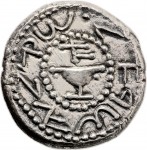 As soon as the Jews had control of Jerusalem, they started striking silver coins of their own using the Tyre shekels as raw material. Doubtless they had practical reasons — revolts cost money and so do Temple taxes — but they were also political and religious statements. By minting their own coins they declared themselves independent and sovereign, no longer required to obey Roman laws in contravention of their own religious strictures.
As soon as the Jews had control of Jerusalem, they started striking silver coins of their own using the Tyre shekels as raw material. Doubtless they had practical reasons — revolts cost money and so do Temple taxes — but they were also political and religious statements. By minting their own coins they declared themselves independent and sovereign, no longer required to obey Roman laws in contravention of their own religious strictures.
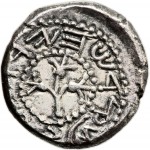 The new shekels were dated from the start of the revolt, so the ones minted in 66 A.D. are inscribed “Year 1.” Moneyers struck a few prototypes first to figure out the design and mechanics of minting large silver coins. Two of those prototypes are known to exist, both struck from the same dies. They were discovered in the late 1970s. One of coins was donated to the Israel Museum in Jerusalem. The other just sold to an anonymous overseas collector for $1.1 million.
The new shekels were dated from the start of the revolt, so the ones minted in 66 A.D. are inscribed “Year 1.” Moneyers struck a few prototypes first to figure out the design and mechanics of minting large silver coins. Two of those prototypes are known to exist, both struck from the same dies. They were discovered in the late 1970s. One of coins was donated to the Israel Museum in Jerusalem. The other just sold to an anonymous overseas collector for $1.1 million.
On the reverse of the coin is a ritual chalice encircled by dots and topped with the Paleo-Hebrew inscriptions “Shekel of Israel” and “Year 1.” On the obverse is a staff with three budding pomegranates, symbols of the fertility of the promised land, encircled by dots and the inscription “Jerusalem the Holy” (in yo face, Tyre!). Each side has an outer border of dots.
You can tell these are prototypes because the images and inscriptions are more complex and off-center than the rest of the Year 1 issue. The reverse of both prototype coins is off-center to the left. There are borders of dots around the inner imagery as well as the outer border of dots. The Paleo-Hebrew alphabet used is more elaborate. Later Year 1 issues are simplified and centered, with only an outer border of dots and with a less intricate lettering.
This shekel is just one of almost 2000 stunning and rare pieces from the Shoshana Collection of ancient Judean coins. The auction last week was only the first part of the sale of this landmark collection which was put together over the course of 40 years by an anonymous West coast collector. The catalogue is a history of ancient Israel in brief and very much worth perusing.
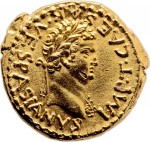
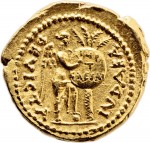 Here’s a video that describes some of the featured pieces, including the Year 1 prototype shekel and this incredible gold aureus of Titus which was minted around 70 A.D. before or during the siege of Jerusalem but still features on the reverse side a Victory hanging a shield inscribed “IMP T CAES” (Imperator Titus Caesar) on a Judean date palm. Along the edges the coin is inscribed IVDAEA DEVICTA or “Judaea is Conquered.” Titus was nothing if not confident. The aureus sold for $956,000.
Here’s a video that describes some of the featured pieces, including the Year 1 prototype shekel and this incredible gold aureus of Titus which was minted around 70 A.D. before or during the siege of Jerusalem but still features on the reverse side a Victory hanging a shield inscribed “IMP T CAES” (Imperator Titus Caesar) on a Judean date palm. Along the edges the coin is inscribed IVDAEA DEVICTA or “Judaea is Conquered.” Titus was nothing if not confident. The aureus sold for $956,000.
[youtube=http://www.youtube.com/watch?v=2cFTTjSzjfA&w=430]